Micro-hydro systems offer an eco-friendly home energy solution by harnessing flowing water to generate electricity. You'll need to assess your property's hydro potential, considering flow rate and head height. Key equipment includes an intake system, penstock, turbine, and generator. Careful planning and design are essential, along with obtaining necessary permits. Regular maintenance guarantees peak performance and longevity. While initial costs vary, the return on investment can be significant over time. You can integrate micro-hydro with existing power systems for greater energy independence. By exploring this sustainable option, you'll discover how to tap into nature's power right in your backyard.
Understanding Micro-Hydro Power Systems
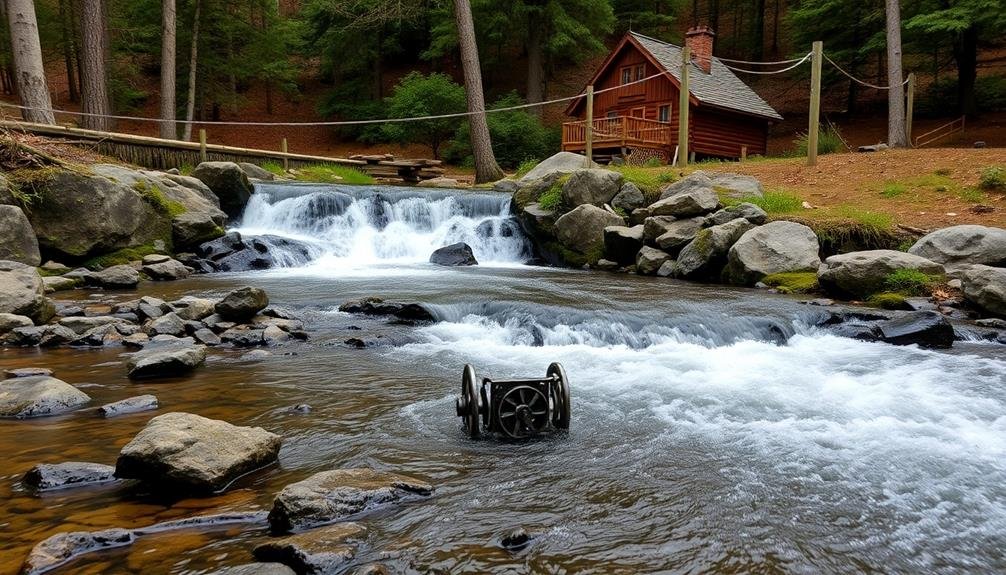
Micro-hydro power systems are small-scale hydroelectric generators that harness the energy of flowing water to produce electricity. These systems can be installed on your property if you have access to a flowing water source like a stream or river.
Unlike large hydroelectric dams, micro-hydro systems have minimal environmental impact and can provide a reliable source of renewable energy for your home.
To understand how micro-hydro works, you'll need to familiarize yourself with its key components. The system consists of an intake, penstock, turbine, generator, and tailrace. Water is diverted from the stream through the intake, then flows down the penstock, a pipe that channels water to the turbine.
The turbine converts the water's kinetic energy into mechanical energy, which drives the generator to produce electricity.
You'll need to evaluate factors like water flow rate, head (vertical drop), and site conditions when contemplating your property's suitability for a micro-hydro system.
It's important to conduct a thorough site evaluation and consult with experts to determine the feasibility and potential output of your system.
With proper planning and implementation, a micro-hydro system can provide a sustainable, cost-effective energy solution for your home.
Assessing Your Property's Hydro Potential
To determine if your property is suitable for a micro-hydro system, you'll need to assess its hydro potential. Start by evaluating your water source's flow rate and head. Flow rate is the volume of water passing through a point per second, while head is the vertical drop from the water source to the turbine. Measure flow rate using a bucket and stopwatch or a flow meter.
Calculate head with a topographic map, GPS device, or professional survey.
Next, consider seasonal variations in water flow. Your system must operate year-round, so account for dry periods. Examine water rights and permits required in your area, as regulations vary by location.
Assess the distance from your water source to your home, as longer distances increase costs and power losses.
Evaluate environmental impacts, such as effects on local ecosystems and fish populations. Consider soil type and stability for pipeline installation.
Analyze your energy needs and compare them to the potential output of your micro-hydro system. Finally, consult with a professional to confirm your assessments and get expert advice on system design and feasibility.
Equipment Needed for Micro-Hydro Installation
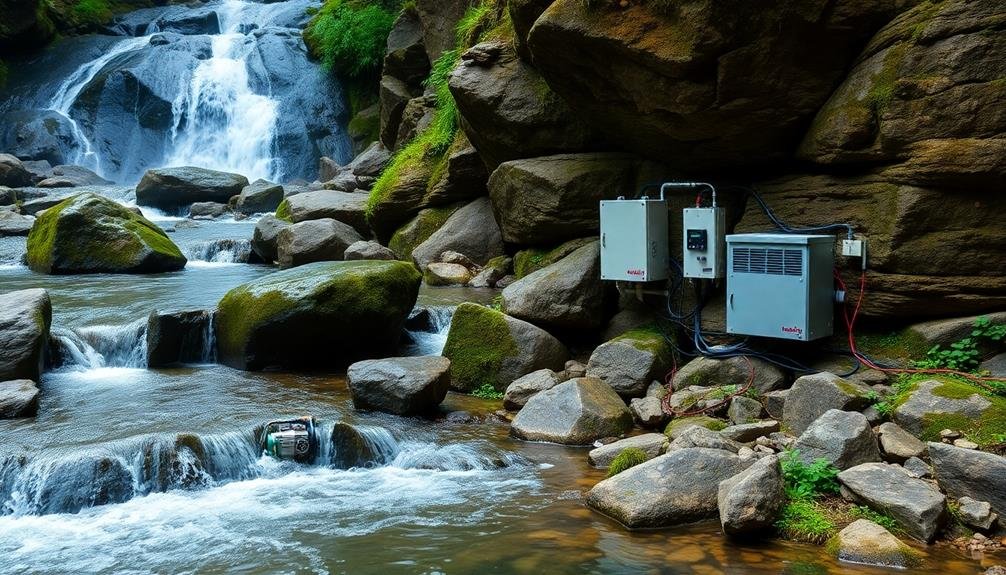
Once you've assessed your property's potential, it's time to gather the essential equipment for your micro-hydro installation. The main components you'll need include:
- Intake system: This consists of a water diversion structure, screening to prevent debris from entering, and piping to channel water to the turbine.
- Penstock: A pipe that carries water from the intake to the turbine, often made of PVC or high-density polyethylene.
- Turbine and generator: The heart of your system, converting the water's energy into electrical power. Choose a turbine type based on your site's head and flow characteristics.
- Control system: Manages the power output and protects the equipment from overload or other issues.
You'll also need electrical components like an inverter to convert DC power to AC, batteries for storage, and wiring to connect everything.
Don't forget safety equipment such as shut-off valves and pressure relief systems. Depending on your location, you may require a tailrace to return water to the stream.
Remember to factor in additional tools for installation and maintenance, like wrenches, multimeters, and waterproof sealants.
Planning and Designing Your System
With your equipment list in hand, it's time to map out your micro-hydro system. Begin by evaluating your property's water resources. Measure the head (vertical drop) and flow rate of your water source. These factors determine your system's potential power output.
Next, decide on your system's layout. Choose an intake location upstream, guaranteeing it's protected from debris and ice. Plan the penstock route, considering terrain and minimizing bends. Select a powerhouse site that's accessible, dry, and close to your home.
Calculate your energy needs and compare them to the system's potential output. This helps you size components correctly and set realistic expectations. Consider seasonal variations in water flow and adjust your plans accordingly.
Design your electrical system, including wiring, inverters, and battery storage if needed. Plan for safety features like shutoff valves and overflow spillways. Don't forget to include a tailrace for returning water to the stream.
Lastly, research local regulations and obtain necessary permits. Consult with experts if you're unsure about any aspect of the design. A well-planned system guarantees efficient, reliable power generation and minimizes environmental impact.
Environmental Considerations and Permits
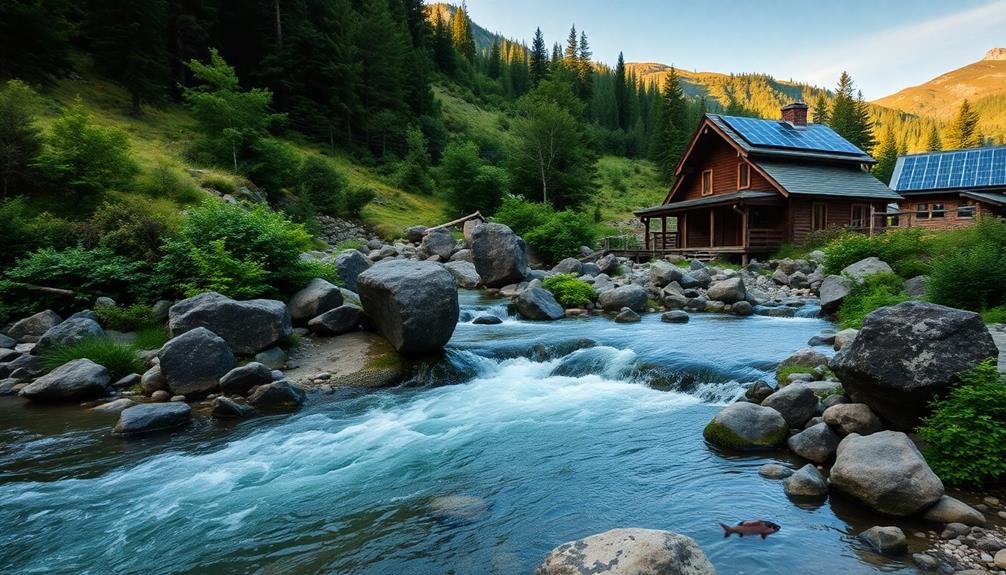
Environmental considerations are paramount when installing a micro-hydro system.
You'll need to assess the impact on local aquatic ecosystems, wildlife, and water quality. It's essential to maintain minimum flow rates to protect fish habitats and guarantee downstream water users aren't affected. You should also consider noise pollution and visual impact on the landscape.
Before proceeding with your project, you'll need to obtain the necessary permits.
The requirements vary depending on your location, but generally include:
- Water rights permits
- Construction permits
- Environmental impact assessments
- Land use approvals
Contact your local water resource department and environmental agency to understand the specific requirements in your area.
They'll guide you through the permitting process and help guarantee your system complies with all regulations.
Installation Process Step-by-Step
You'll begin the micro-hydro installation process with a thorough site assessment and planning phase.
Next, you'll set up and place the equipment, including the turbine, generator, and necessary piping.
Site Assessment and Planning
Careful planning is the cornerstone of a successful micro-hydro installation. Before you engage in the project, it's vital to assess your site's potential and create a thorough plan. Start by evaluating your property's water resources, including streams, rivers, or springs. You'll need to determine the available head (vertical drop) and flow rate to calculate potential power output.
Next, consider these key factors in your site assessment:
- Water rights and regulations: Confirm you have the legal right to use the water source and comply with local environmental regulations.
- Seasonal variations: Measure water flow throughout the year to account for fluctuations during dry and wet seasons.
- Site access: Evaluate the terrain and accessibility for equipment installation and maintenance.
- Environmental impact: Assess potential effects on local ecosystems, fish populations, and wildlife habitats.
Once you've gathered this information, create a detailed site plan. Include the layout of your micro-hydro system, pipeline routes, and powerhouse location.
Don't forget to factor in electrical transmission to your home and grid connection requirements. A well-executed site assessment and plan will set the foundation for a smooth installation process and efficient micro-hydro system.
Equipment Setup and Placement
With your site assessment complete and plan in hand, it's time to begin the installation process. Start by installing the intake system, which includes a screen to filter debris and a pipe to channel water. Verify the intake is securely anchored and positioned to capture the maximum flow.
Next, lay the penstock pipe along the planned route, using support structures where necessary to maintain proper slope. Install pressure relief valves at strategic points to prevent damage from water hammer effects.
Set up the powerhouse, which will house your turbine and generator. Make certain it's on stable ground and protected from potential flooding. Install the turbine, aligning it precisely with the penstock pipe. Connect the generator to the turbine shaft, verifying proper coupling.
Install the electrical components, including the control panel, inverter, and batteries if you're using a DC system. Set up proper grounding and safety devices.
Finally, construct the tailrace to return water to the stream. Confirm it's designed to prevent erosion and maintain water quality.
Throughout the installation, double-check measurements and connections to confirm peak system performance and safety.
Connecting to Power Grid
Connecting your micro-hydro system to the power grid marks the final step in the installation process. Before you begin, verify you've obtained all necessary permits and approvals from your local utility company.
You'll need to work with a licensed electrician to safely connect your system to the grid.
Follow these steps to complete the grid connection:
- Install a grid-tie inverter: This device converts the DC power from your micro-hydro system into AC power compatible with the grid.
- Set up metering equipment: Your utility company will provide a bi-directional meter to measure both the electricity you consume and the excess power you feed back into the grid.
- Install safety disconnects: These allow you to isolate your system from the grid during maintenance or power outages.
- Connect to the main service panel: Your electrician will wire the inverter output to your home's main electrical panel, verifying proper integration with your existing electrical system.
Once connected, you'll be able to use power from both your micro-hydro system and the grid.
Any excess electricity you generate can be fed back into the grid, potentially earning you credits on your utility bill.
Remember to schedule regular maintenance to keep your system running efficiently and safely.
Maintenance and Troubleshooting
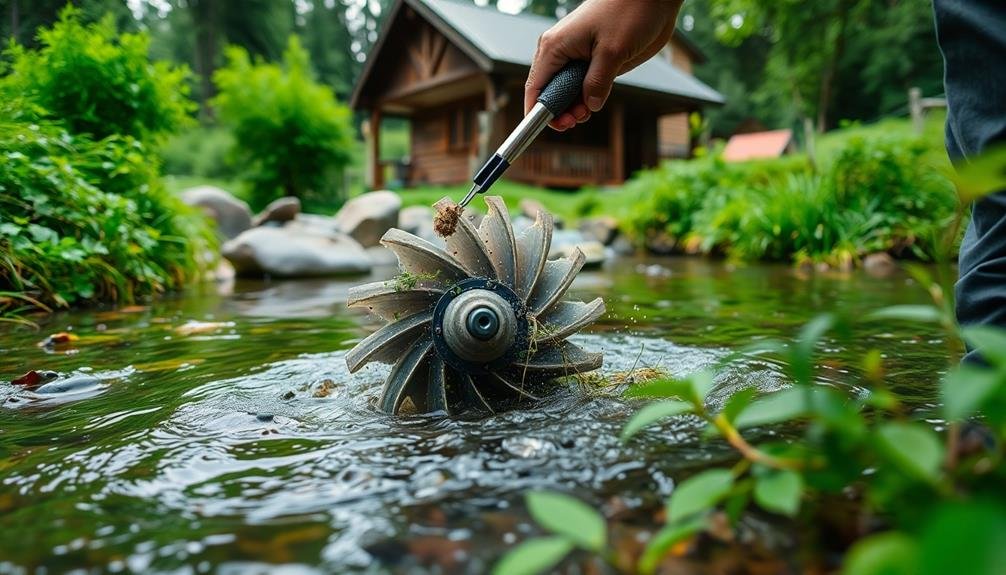
To keep your micro-hydro system running smoothly, you'll need to establish a regular inspection schedule and address common issues promptly.
You can handle some maintenance tasks yourself, but certain problems may require professional intervention.
Understanding the difference between DIY and expert-level maintenance will help you manage your system effectively and guarantee its longevity.
Regular Inspection Schedule
Keeping your micro-hydro system in prime condition requires a consistent inspection routine. By adhering to a regular schedule, you'll catch potential issues early and guarantee peak performance. Aim to inspect your system at least once a month, with more frequent checks during high-flow seasons or after severe weather events.
During your inspections, focus on these key areas:
- Intake and pipeline: Check for debris buildup, leaks, or damage. Clear any obstructions and repair any visible issues promptly.
- Turbine and generator: Listen for unusual noises, inspect bearings for wear, and guarantee proper lubrication. Look for signs of corrosion or damage to the turbine blades.
- Electrical components: Examine wiring connections, batteries, and inverters for loose connections, corrosion, or signs of overheating.
- Water flow and output: Monitor water levels, flow rates, and power output to detect any unexpected changes in system performance.
Keep a detailed log of your inspections, noting any observations or maintenance performed. This record will help you identify patterns and anticipate potential problems.
Don't hesitate to consult a professional if you encounter issues beyond your expertise. Regular inspections and timely maintenance will extend your micro-hydro system's lifespan and enhance its efficiency.
Common Issues Addressed
While regular inspections help prevent issues, you'll likely encounter some common problems with your micro-hydro system over time. One frequent issue is debris clogging the intake screen, reducing water flow and power output. You'll need to clean the screen regularly, especially after heavy rainfall or during autumn when leaves fall.
Sediment buildup in the penstock or turbine can decrease efficiency. Flush the system periodically and consider installing a settling tank to minimize this problem.
Wear and tear on turbine components, such as bearings or seals, may cause reduced performance or unusual noises. Replace these parts as needed to maintain peak function.
Electrical issues can arise from moisture infiltration or loose connections. Inspect wiring and connections regularly, ensuring proper insulation and tightening any loose components. If you notice fluctuations in power output, check for air pockets in the penstock or misalignment of the turbine shaft.
Freezing can damage pipes and components in colder climates. Implement appropriate insulation and heating measures to protect your system during winter months.
Professional Vs DIY Maintenance
The decision between professional and DIY maintenance for your micro-hydro system hinges on your technical skills and comfort level. If you're handy and enjoy problem-solving, you might opt for DIY maintenance.
However, professional services offer expertise and can save you time and potential headaches.
When considering DIY maintenance, focus on these key areas:
- Regular inspections: Check for debris in the intake, wear on turbine blades, and proper lubrication of moving parts.
- Water flow monitoring: Verify consistent water flow and pressure for peak performance.
- Electrical system checks: Inspect wiring, connections, and battery banks for signs of wear or corrosion.
- Seasonal adjustments: Adapt your system to changing water levels and flow rates throughout the year.
For complex issues or if you're unsure about handling electrical components, it's best to call in a professional. They'll have specialized tools and knowledge to diagnose and fix problems efficiently.
Remember, improper maintenance can lead to system damage or inefficiency, potentially costing you more in the long run.
Weigh your skills against the complexity of your system to make the best choice for your micro-hydro maintenance needs.
Cost Analysis and ROI
Frequently, homeowners considering micro-hydro systems wonder about the financial implications. The initial costs can vary widely, typically ranging from $5,000 to $50,000, depending on your site's characteristics and power needs. Key factors influencing cost include the head (vertical drop), flow rate, pipeline length, and system capacity.
Your return on investment (ROI) depends on several factors. First, calculate your current annual electricity costs. Then, estimate the potential energy output of your micro-hydro system. Most systems can produce power 24/7, unlike solar or wind.
You'll need to factor in maintenance costs, which are generally low but can vary based on system complexity. The payback period for a micro-hydro system usually ranges from 5 to 10 years. However, with proper maintenance, these systems can last 20-30 years or more, providing significant long-term savings.
Don't forget to research available incentives, such as tax credits or grants, which can substantially reduce your initial investment and improve ROI. Additionally, consider the potential increase in property value and the environmental benefits when evaluating the overall return on your micro-hydro investment.
Integrating With Existing Power Systems
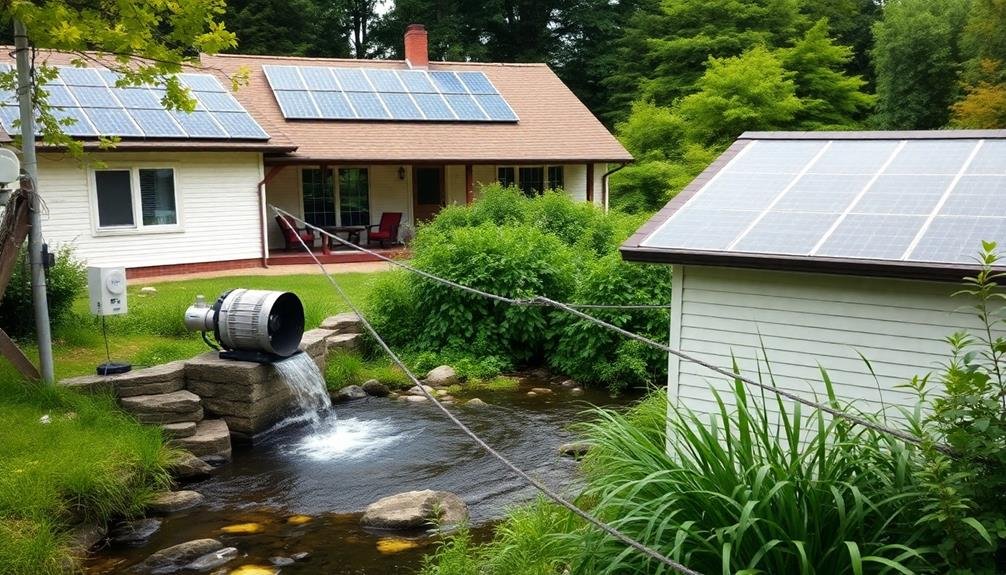
Integrating a micro-hydro system with your existing power setup involves three main approaches. You can choose to operate off-grid, connect to the utility grid, or create a hybrid system. Each option has its own benefits and challenges, so consider your specific needs and local regulations before deciding.
When integrating your micro-hydro system, follow these key steps:
- Assess your current power system and determine compatibility with micro-hydro equipment.
- Install necessary components like inverters, charge controllers, and batteries if going off-grid.
- Set up grid-tie equipment for connecting to the utility network, if applicable.
- Implement a control system to manage power flow between sources.
For grid-connected systems, you'll need to meet utility requirements and obtain proper permits. Off-grid setups require careful sizing of batteries and backup generators to guarantee reliable power.
Hybrid systems offer flexibility by combining grid connection with battery storage.
Remember to consult with a professional electrician or micro-hydro specialist to guarantee proper integration and safety. They'll help you navigate technical challenges and optimize your system's performance.
With the right approach, you can seamlessly incorporate micro-hydro power into your existing energy infrastructure.
Case Studies of Successful Installations
You'll find inspiration in these real-world micro-hydro success stories.
A remote mountain retreat harnesses a swift creek to power an off-grid cabin.
In an urban setting, a homeowner taps into a small stream running through their property, while a farm integrates a micro-hydro system with their existing irrigation infrastructure.
Remote Mountain Retreat
While many dream of living off-grid in a remote mountain retreat, John and Sarah Miller turned that dream into reality with their micro-hydro installation in Colorado's Rocky Mountains. Their property, situated along a year-round stream with a 100-foot elevation drop, provided the perfect conditions for a micro-hydro system.
The Millers' journey to energy independence involved:
- Evaluating the stream's flow rate and head to determine potential power output
- Designing a system that could withstand harsh mountain conditions
- Obtaining necessary permits and addressing environmental concerns
- Installing a 5kW turbine, penstock, and tailrace with minimal ecosystem disruption
Their system now generates an average of 3,500 kWh per month, more than enough to power their 2,000 sq ft home and workshop.
Excess energy is stored in a battery bank for use during maintenance or low-flow periods.
You'll find that the Millers' success story showcases the potential of micro-hydro in remote locations.
They've achieved complete energy independence, reduced their carbon footprint, and enjoy the peace of mind that comes with a reliable, renewable power source in their mountain paradise.
Urban Stream Utilization
Urban streams, often overlooked as potential energy sources, are gaining attention for their micro-hydro potential. Several successful installations have demonstrated the viability of harnessing these urban waterways for clean energy production.
In Portland, Oregon, a homeowner installed a micro-hydro system on a small creek running through their property. The system generates 1.5 kW of continuous power, meeting 70% of the household's electricity needs. The installation required minimal environmental disruption and operates quietly, preserving the stream's natural aesthetics.
Another notable case is in Seattle, Washington, where a community project utilizes a restored urban stream to power a local community center. The 3 kW system not only provides electricity but also serves as an educational tool, raising awareness about renewable energy and water conservation.
In Boulder, Colorado, a micro-hydro installation on a steep residential property uses runoff from a hillside spring. This innovative setup produces 0.8 kW of power, enough to cover the home's basic electrical needs and charge an electric vehicle.
These case studies highlight the untapped potential of urban streams for sustainable energy production, offering inspiration for homeowners and communities seeking eco-friendly power solutions.
Farm Irrigation System
Moving from urban streams to rural settings, farm irrigation systems offer another promising avenue for micro-hydro energy generation.
You'll find that farmers have successfully harnessed the power of water flowing through their irrigation networks to create sustainable energy solutions. These systems not only provide electricity but also help reduce operating costs and carbon footprints.
Let's explore four successful case studies of farm irrigation micro-hydro installations:
- The Johnson Family Farm in Oregon: Installed a 10kW system on their existing irrigation canal, powering their entire farming operation and selling excess electricity back to the grid.
- Green Valley Cooperative in California: Implemented a 25kW system across multiple farms, sharing the benefits and costs among members.
- Hillside Orchards in Washington: Utilized a 5kW system to power their cold storage facilities, greatly reducing energy costs.
- Sundance Ranch in Colorado: Installed a 15kW system that powers their barn, farmhouse, and electric fencing for livestock management.
These examples demonstrate how you can integrate micro-hydro systems into existing farm infrastructure, maximizing water usage and creating a sustainable energy source.
Frequently Asked Questions
Can Micro-Hydro Systems Work in Areas With Seasonal Water Flow?
Yes, micro-hydro systems can work in areas with seasonal water flow. You'll need to design your system to accommodate fluctuations. During low-flow periods, you may need to supplement with other energy sources or reduce your power consumption.
How Noisy Are Micro-Hydro Systems Compared to Other Renewable Energy Sources?
You'll find micro-hydro systems are typically quieter than wind turbines. They're often as silent as solar panels, with only a slight hum from the generator. Proper installation can minimize noise, making them nearly unnoticeable in your daily life.
Is It Possible to Sell Excess Electricity Generated by Micro-Hydro?
Yes, you can often sell excess electricity from your micro-hydro system. You'll need to check local regulations and connect to the grid. Many utility companies offer net metering programs, allowing you to earn credits for surplus power.
What Happens to Aquatic Life When Water Is Diverted for Micro-Hydro?
When you divert water for micro-hydro, you'll impact aquatic life. Fish may struggle to migrate, and habitats can be altered. However, you can minimize these effects by using fish-friendly turbines and maintaining sufficient water flow.
Can Micro-Hydro Systems Be Combined With Other Renewable Energy Sources?
Yes, you can combine micro-hydro with other renewables. You'll often see it paired with solar or wind power. This creates a more reliable energy system, as you're not relying on just one source for your electricity needs.
In Summary
You've now got an extensive understanding of micro-hydro power systems. With the right property and resources, you can harness clean, renewable energy from flowing water. Remember to assess your site carefully, plan thoroughly, and consider environmental impacts. While initial costs may be significant, the long-term benefits can be substantial. Don't forget to maintain your system regularly and integrate it wisely with existing power sources. You're now ready to explore this eco-friendly energy solution for your home.

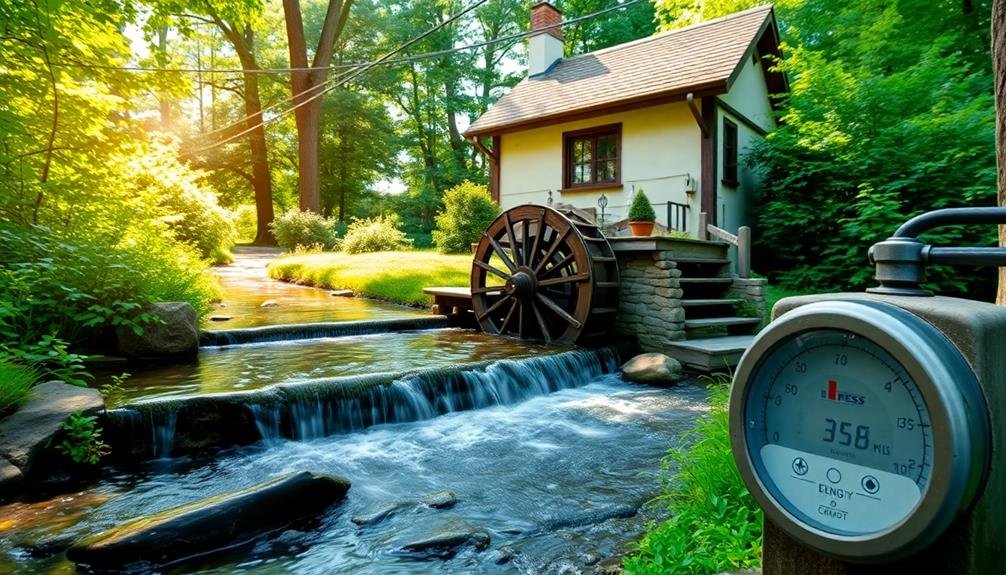
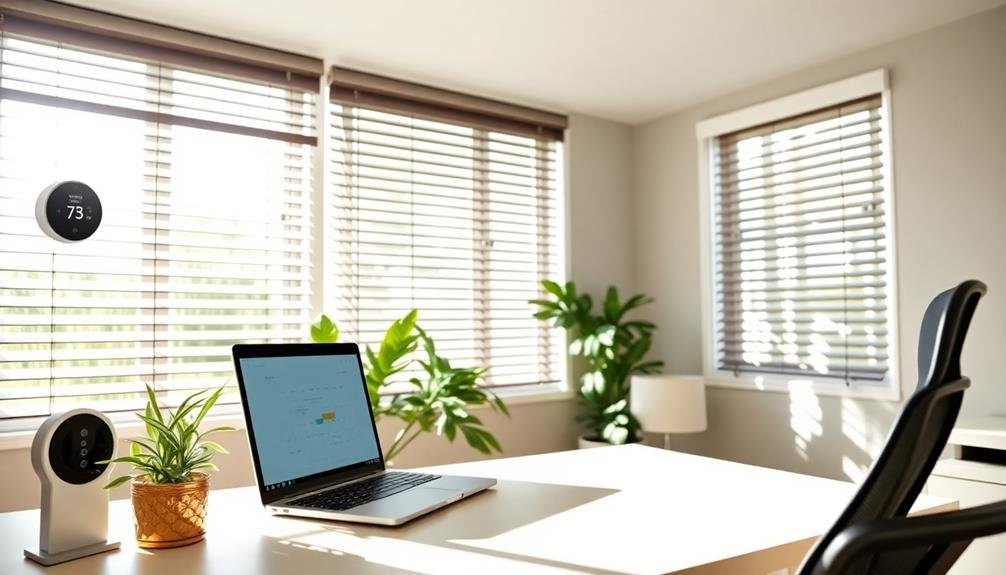
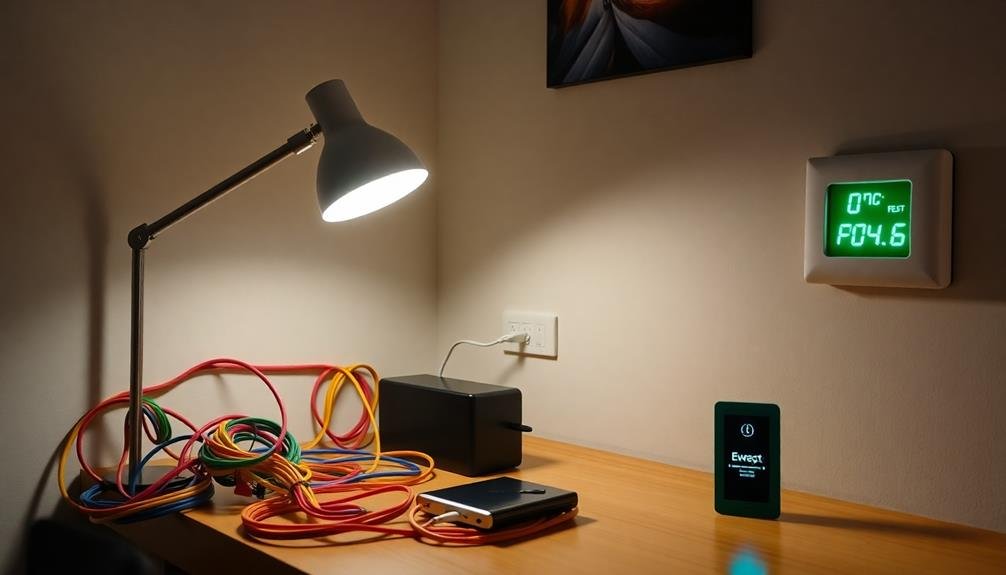
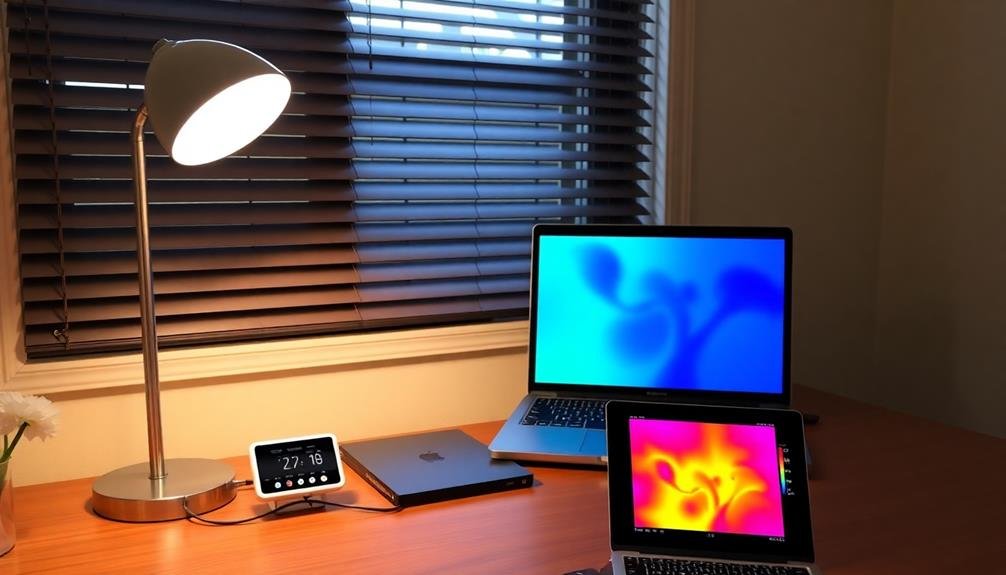
Leave a Reply